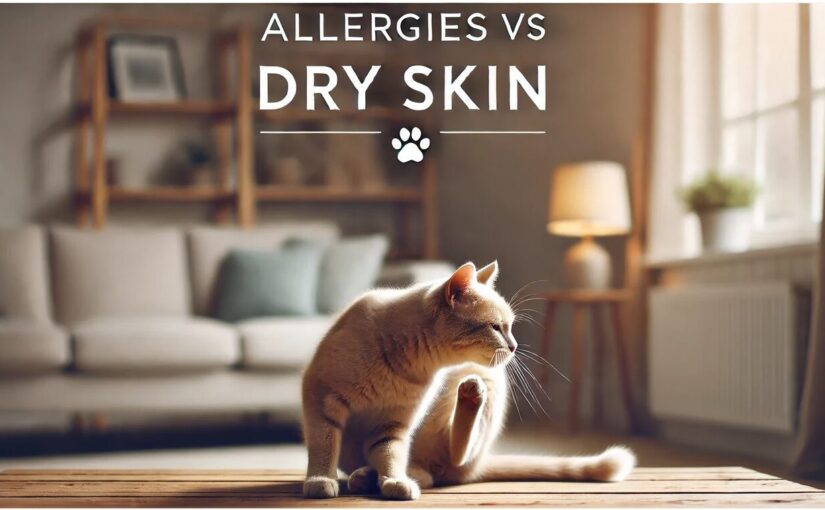Cats are fascinating creatures, but like humans, they can suffer from allergies. Identifying the signs of allergies and distinguishing them from issues like dry skin is crucial for ensuring your feline companion’s comfort and health. Here’s what you need to know about the top cat allergies, their symptoms, and how to tell if your cat’s issue is more than just dry skin.
What Are Cat Allergies?
Allergies in cats occur when their immune system overreacts to a substance it perceives as harmful. These substances, called allergens, can come from various sources, including food, the environment, and parasites. While allergies aren’t curable, they can be managed effectively with proper care.
Common Types of Cat Allergies
1. Food Allergies
Food allergies are one of the most common causes of allergic reactions in cats. They often stem from proteins in the diet, such as chicken, beef, fish, or dairy. Cats can develop food allergies at any age, even to foods they’ve eaten for years.
Symptoms:
- Itchy skin, often around the face, ears, and neck
- Gastrointestinal issues like vomiting or diarrhea
- Excessive grooming
- Hair loss or bald spots
2. Environmental Allergies (Atopic Dermatitis)
Environmental allergens include pollen, mold, dust mites, and even certain cleaning products. Seasonal allergies, similar to hay fever in humans, can also affect cats.
Symptoms:
- Frequent sneezing or coughing
- Watery or red eyes
- Itchy skin, especially around the paws and ears
- Scabs or open sores from scratching
3. Flea Allergy Dermatitis
Cats allergic to flea saliva can have severe reactions to even a single flea bite. Flea allergy dermatitis is one of the most common allergic conditions in cats.
Symptoms:
- Intense itching, particularly around the base of the tail
- Red, inflamed skin
- Small scabs or crusty lesions (often called “flea dirt”)
- Hair loss in affected areas
4. Contact Allergies
Contact allergies occur when a cat’s skin comes into direct contact with an allergen, such as certain fabrics, chemicals, or plants.
Symptoms:
- Localized redness or irritation
- Persistent scratching at the affected area
- Swelling or hives
Dry Skin: A Common Misdiagnosis
Dry skin in cats can mimic some allergy symptoms, making it easy to confuse the two. Dry skin may occur due to:
- Low humidity
- Poor diet lacking essential fatty acids
- Overbathing
- Medical conditions like hypothyroidism
Symptoms of Dry Skin:
- Flaky, dandruff-like appearance
- Dull or coarse fur
- Mild itchiness without sores or redness
- Skin that feels rough to the touch
How to Tell the Difference Between Allergies and Dry Skin
Understanding whether your cat is dealing with allergies or dry skin involves observing their behavior and symptoms closely. Here are key differences:
1. Severity and Location of Itchiness
- Allergies: Itchiness is often intense and localized, such as around the face, paws, or tail.
- Dry Skin: Itchiness tends to be mild and more generalized.
2. Presence of Lesions or Redness
- Allergies: Look for red, inflamed areas, scabs, or open sores caused by excessive scratching.
- Dry Skin: Flaking and dull fur are more common without visible inflammation.
3. Other Symptoms
- Allergies: Cats with allergies often have accompanying symptoms like sneezing, watery eyes, or gastrointestinal upset.
- Dry Skin: Typically limited to skin and fur issues without systemic signs.
4. Response to Environmental Changes
- Allergies: Symptoms may worsen seasonally or when exposed to specific triggers.
- Dry Skin: May improve with adjustments like adding a humidifier or dietary supplements.
Diagnosis and Treatment
If you’re unsure whether your cat is suffering from allergies or dry skin, it’s best to consult a veterinarian. They may recommend:
- Skin Scraping or Allergy Testing: To identify specific allergens.
- Food Trials: To determine food sensitivities.
- Flea Prevention: To rule out flea allergy dermatitis.
Treatment Options
- For Allergies:
- Antihistamines or corticosteroids for immediate relief.
- Immunotherapy for long-term management.
- Prescription diets for food allergies.
- For Dry Skin:
- Omega-3 fatty acid supplements to improve skin health.
- Regular grooming to distribute natural oils.
- Using gentle, hypoallergenic shampoos.
Final Thoughts
Caring for a cat with allergies or dry skin requires patience and attention to detail. By observing your cat’s symptoms and working closely with your vet, you can ensure they stay comfortable and happy. Remember, small changes in your cat’s environment or diet can make a big difference in their overall well-being.







Some really nice stuff on this web site, I love it.
Enjoyed looking at this, very good stuff, regards.